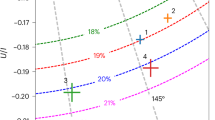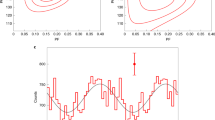Abstract
MEASUREMENT of optical polarization has of course been limited to NP 0532. The optical radiation in both the main pulse and the interpulse, averaged over many pulses, is weakly linearly polarized (∼15 per cent) with a position angle which rotates in a manner akin to that in PSR 0833–45 (refs. 1 and 2). The polarization properties, as well as the total intensity and pulse shape, seem to be time-dependent, however3. Circular polarization is absent.
This is a preview of subscription content, access via your institution
Access options
Subscribe to this journal
Receive 51 print issues and online access
$199.00 per year
only $3.90 per issue
Buy this article
- Purchase on Springer Link
- Instant access to full article PDF
Prices may be subject to local taxes which are calculated during checkout
Similar content being viewed by others
References
Wampler, E. J., Scargle, J. D., and Miller, J. S., Astrophys. J. Lett., 157, L1 (1969).
Warner, B., Nather, R. E., and MacFarlane, M., Nature, 222, 233 (1969).
Cocke, W. J., Disney, M. J., and Gehrels, T., Nature, 223, 576 (1969).
Staelin, D. H., and Reifenstein, E. C. III, Science, 162, 1481 (1968).
Cohen, M., Proc. IRE, 46, 183 (1958).
Radhakrishnan, V., and Cooke, D. J., Astrophys. Lett., 3, 225 (1969).
Author information
Authors and Affiliations
Rights and permissions
About this article
Cite this article
CAMPBELL, D., HEILES, C. & RANKIN, J. Pulsar NP 0532: Average Polarization and Daily Variability at 430 MHz. Nature 225, 527–528 (1970). https://doi.org/10.1038/225527a0
Received:
Issue Date:
DOI: https://doi.org/10.1038/225527a0
This article is cited by
-
Morphology and characteristics of radio pulsars
The Astronomy and Astrophysics Review (2004)
-
The crab nebula
Astrophysics and Space Science (1973)
-
Characteristics of Subpulses of Pulsar CP 1133
Nature Physical Science (1972)
-
Rotation Measure and Intrinsic Angle of the Crab Pulsar Radio Emission
Nature Physical Science (1971)
-
Rotation Axis and Magnetic Field Axis of the Crab Nebula Pulsar PSR 0532 + 22
Nature Physical Science (1971)
Comments
By submitting a comment you agree to abide by our Terms and Community Guidelines. If you find something abusive or that does not comply with our terms or guidelines please flag it as inappropriate.



